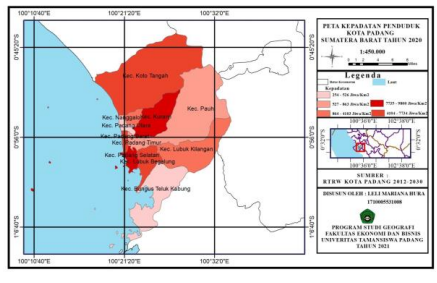ANALISIS KEPADATAN PENDUDUK TERHADAP TINGKAT PENGANGGURAN SEBELUM DAN DI SAAT (COVID-19) DI KOTA PADANG
Main Article Content
Abstract
This study aims to analyze population density and its effect on the unemployment rate that occurred in the city of Padang (before and during Covid-19) as well as the policies taken to overcome the existing unemployment rate. The sample of this research is the people who are the labor force in the city of Padang. Management of research data is carried out using Arcgis or GIS software which produces maps of population density levels and Simple Linear Regression using SPSS Software. This type of research used is quantitative descriptive research. Base on result, it shows that the population density in the city of Padang has increased by 242 people/km2 in 2020 by having as many as four (4) density classification classes consisting of class I (low density), class II (medium density), class III (slightlyhighdensity) and classification IV (highdensity). The largest population concentration in the districts of East Padang, North Padang and Nanggalo. In addition, the effect of population density on the unemployment rate in Padang City is 62% in 2019 and 69% in 2020. Thus, it can be concluded that in 2020 the unemployment rate has increased by 7%, this is due to population density, which continues to increase and is added by the Covid-19 pandemic which affects the depletion of community jobs.
Article Details

This work is licensed under a Creative Commons Attribution-NonCommercial-ShareAlike 4.0 International License.
With the receipt of the article by the Jurnal Azimut Editorial Board and the decision to be published, then the copyright regarding the article will be diverted to Jurnal Azimut.
Geography Department, Universitas Tamansiswa Padang as the publisher of Jurnal Azimut hold the copyright regarding all the published articles in this journal.
Geography Department, Universitas Tamansiswa Padang has the right to multiply and distribute the article and every author is not allowed to publish the same article that was published in this journal.
References
Arikunto, Suharsimi. 2006. Prosedur Penelitian : Suatu Pendekatan Praktik, Edisi Revisi VI. Jakarta : PT Rineka Cipta.
Badan Pusat Statistik Kota Padang. Kota Padang dalam angka 2015-2020. Sumatera Barat.
Ghozali, Imam. 2011. “Aplikasi Analisis Multivariate Dengan Program SPSS”. Jurnal. Semarang.
Husein, Umar. 2008. Metode Penelitian Untuk Skripsi dan Tesis Bisnis. Jakarta. PT Rajagrafindo Persada.
Karim Sutarman, 2006.Pemetaan Topografi 2D dan Pemodelan Relief Rupa Bumi Tiga Dimensi 3D Kota Padang Sumatera Barat. Jurnal. Padang.
Mu’minin, Amirul M. 2017. Pengaruh pertumbuhan Ekonomi dan Jumlah Penduduk terhadap Tingkat Pengagguran Terbuka di Kabupaten/Kota Provinsi Jawa Timur Tahun 2011-2015. Jurnal. Jawa Timur.
Muljaningsih, sri. 2022. Analisis Pengaruh Jumlah Penduduk, Tingkat Pengangguran dan Tingkat Pendidikan Terhadap Kemiskinan di Kabupaten Gersik. Jurnal. Lampung.
Nursalam. 2013. Metodologi Penelitian Ilmu Keperawatan: Pendekatan Praktis. Jakarta. SalembaMedika.
Usman, Umaruddin dkk. 2018. Pengaruh Jumlah Penduduk, Pengangguran dan Pertumbuhan Ekonomi terhadap Kemiskinan di Provinsi Kepulauan Riau. Jurnal. Riau
Undang-Undang Nomor 24 Tahun 2007 tentang Pengaggulangan Bencana,
(2007).

